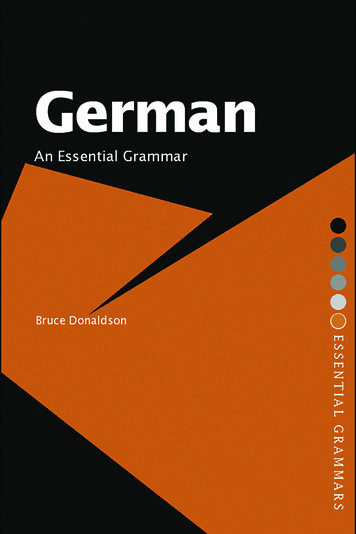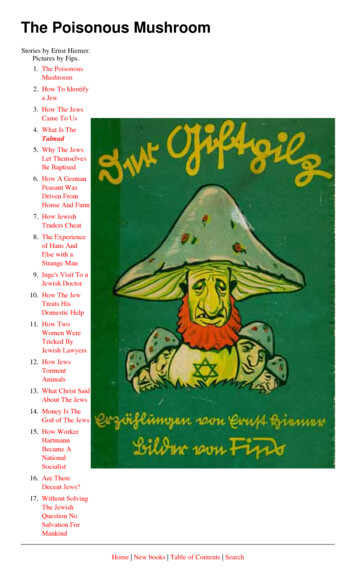
Transcription
Writing to Learn GermanDeborah PetersonBethel High School, Bethel, WashingtonThe ultimate goal of foreign language instruction is to teach studentsthe skills needed to communicate in the foreign language. For this, students need insight into cultural and historical phenomena, as well asknowledge of grammatical functions . They need to trust their teacherand classmates before they will be willing to speak another languageand make the mistakes that nonnative speakers are bound to make.And speaking in the foreign language is essential because studentsmust move from acquisition to application of skills .Writing-to-learn techniques help students begin to communicatesuccessfully in the foreign language, reducing students' fears of making errors and looking dumb. In addition, writing to learn helped students understand grammatical functions, historical events, andcultural phenomena. In this chapter I will describe how my studentswrite to improve speaking, to learn grammar, to simulate real-life situations, and to understand cultural concepts.OrganizingThe foundation for use of writing-to-learn techniques in my classes wasthe journal. The journal, a three-ring binder, was a student log of activities as well as a place to record thought processes. Students also kepthandouts such as song sheets and news articles in the journal. Thejournal organized students physically, an obvious advantage . It also organized students mentally; if they were unable to record their thoughtson paper, they knew their understanding was weak, and they wouldseek help. Students knew they would write on a daily basis and cameto realize that daily writing projects would help them reach the goal ofa lesson. I used a partner system so that students would share theirwork on a regular basis and get feedback on it. For many, consistent useof the journal provided tangible evidence that each day was important46
Writing to Learn German47and that each activity was a stepping stone toward mastery of the unit.Students dated and labeled each entry and kept work in chronological order. If we were working on command forms on Monday and Friday's assignment involved commands, students would often refreshtheir memories by going through their journals to review the week'snotes and exercises. Before they began using journals, such a reviewwould have been more difficult.Since the journal contained expressive language, which tends to bepersonal, students preferred to review their own notes, rather than askme to review material in class. Considering the number of interactionsteachers have with students each hour, students and teachers can bothbenefit from a procedure that enables students to help themselves byrelying on their own knowledge and records. The journals also helpedthe students who missed class; they could find out from classmateswhat the assignment was and ask me for additional help if necessary.That the students valued the journal was especially clear to me thelast week of school. As I collected the journals to review their contentone last time, I mentioned that I might not be ready to give them backuntil the afternoon of the last day of school. Many concerned studentscame to me after class and during lunch to tell me how much theyneeded the journal and to ask if they could pick it up earlier. They genuinely desired to have and use the journal the following year, and someambitious students wanted to use it over the summer vacation. Evengraduating seniors came back to get their journals.Speaking SkillsSpeaking skills receive the greatest emphasis in the foreign languageclassroom because achieving communicative competence requiresmaking the transition from "skill-getting" to "skill-using." I want mystudents to control the German language, not have it control them . Ioften used writing-to-learn techniques in my classes to help studentsimprove their oral German. These writing projects usually involved visual cues that the speaker and listener could use to increase understanding. These techniques provided "stepping stones" for the speakerreducing anxiety and assuring success.One assignment in the beginning German class asked students to introduce themselves and each other. The chapter in our text introducedthe vocabulary and provided a dialogue for using it. It also covered possessive pronouns and their endings . As we read various dialogues inthe text, we made lists of characteristics we would need to describepeople. They were divided according to categories: eye color, hair color,
48Deborah Petersonfavorite sport, favorite class, and so on. Students wrote all the possibilities, not just those that applied to them. The listing exercise helpedreinforce what they had previously learned: spellings and meanings ofwords. After finishing the lists, students circled those items that applied to them. This allowed them to focus on the vocabulary they wouldneed to introduce themselves.We then began to produce cards that would be visual aids for speaking exercises. Students brought pictures of themselves from home;these were glued to five-by-seven-inch cards. They recorded on theircards what they perceived as the most important information aboutthemselves . They were not allowed to write full sentences, only skeletalinformation, for bbies:Lieblingssport:Lieblingsfach:Lieblingsgru ppe:Konrad R. Whitney17 Jahre altTacoma, Washington, USAblondblauMalen, Wandern, Essen, Camping,Lesen, SportFussball, Korbball, Schwimmen,FootballSportBlue Oyster CultTranslationName:Konrad R. WhitneyAge:Residence :Hair color:17 years oldTacoma, Washington, USAEye color:Hobbies:blondbluedrawing, hiking, eating, camping,reading, sportsFavorite sport:soccer, basketball, swimming,footballFavorite subject:Favorite group:sportsBlue Oyster Cult
Writing to Learn German49Before beginning the exercise, we reviewed subject-verb agreementwith the verb "to like." And I reminded the students that the listenersalso had visual cues for comprehension, since the pictures and the person matched the vocabulary. They saw the word fussball on Konrad'scard at the same time they saw his blond hair and blue eyes .Before students spoke to the class, they were given a few minutes topractice introducing themselves, with their partners as the audience .Students now had been led through all the steps to get to the goal ofintroducing themselves fluently and confidently.During the introductions to the class, speakers were encouraged touse the cards as cues. Listeners were encouraged to ask questions ofthe speakers, just as would happen in real-life conversations. Studentsinteracted very well; they were interested in learning about each otherand in telling about themselves. The cue cards and the listmaking thatled to the production of the cue cards fostered confidence.When writing the cards, students had time to think through theproject. They knew the goal, and they wanted to communicate accurateinformation. Their knowledge of the words and grammatical functionswas reinforced as they made their lists and used the lists to make theirown cards. As they moved to higher levels of thinking (the comprehension and application levels), students were able to depend on their writing to help them communicate orally with their peers. The speakingactivity was not spontaneous, but it gave them practice for speaking inreal-life situations .Writing-to-learn techniques such as brainstorming, clustering, lists,and first thoughts can be used to assure successful communication .These techniques can help students complete the following traditionalassignments.TopicMaterialTravelingMake a travel brochure of a placeyou've visited in Germany, Austria,Switzerland, or the United States.Use pictures and cue words, but notfull sentences. You'll use your brochure to introduce the travel destination to the class.Breakfast FoodsBring in pictures of your favoriteGerman breakfast foods. Write anadvertisement and use it to make anoral presentation to the class.
Deborah Peterson50SportsBring in a picture of your favoriteathlete. Write her or his biographyand make an oral report to theclass.PartyMake invitations to a party. Includethe following on the card: What theoccasion is, When the party is,Where, and Who is invited to theparty.The advantage of writing-to-learn speaking is clear: students arecommunicating once when writing the information and again whenspeaking. The cue cards provide visual cues and are produced by students. Furthermore, they incorporate students' diverse interests. Materials can be used repeatedly by varying the actual speaking exercisesto fit the goal of the specific lesson. For example, the cards studentsused to introduce themselves were used later in the year to discussclothes, colors, and fashions. Students enjoyed seeing their classmates'cards and discussing them.Learning GrammarLearning grammar is another goal in foreign language class. Many students get their first taste of grammar rules in the foreign language classroom. Some students apply grammatical concepts easily; othersstruggle continually with terms and concepts. Often students can repeat from memory how a given part of the sentence is defined, yet theycannot identify that part of the sentence or explain why one would needto know what part of the sentence a word is.In German the speaker must know what part of the sentence eachphrase is because the definite articles change to reflect the function ofthe nouns they precede. For example, in English the definite article remains the same regardless of the noun's function. While in Germanthere are six choices of definite articles (der, die, das, den, dem , and des).Writing-to-learn exercises can help students understand this and othergrammatical functions .My favorite exercises for teaching grammar are dictation and varythe-audience. For example, when I introduced students to the conversational past tense, I asked them to copy my definition of the tense.After they copied it, I explained it to them in greater detail and answered their questions. To confirm their understanding, I asked themto write in their journals how they would explain the conversational
Writing to Learn Ger111an51past tense to a grade school child. Students occasionally explain concepts to classmates who have been absent, but to explain a concept toa young child, they need to use simple language with clear examplesthat reflect a thorough understanding of the concepts involved. Thisvariation in audience made some students realize that they did not understand the concepts well enough to explain them to their peers, letalone to younger kids. Others realized how well they did comprehendtense, and they were able to help students who were having difficulty.The dictation and vary-the-audience exercises were my favorite because I could monitor the students as they worked and get immediatefeedback on their understanding and ability to apply concepts. Students did not have to flunk a test before they or I realized they neededhelp . The writing exercises helped them process the information andeventually master the concepts.All of the work was done in the journal, and many students referredback to their grammar dictation and vary-the-audience exercises whenworking on composition assignments. They preferred to use their ownwork when they had questions rather than the textbook. In most situations, students were able to rely on themselves and on their partnerswhen they needed to review previously covered material.Writing in GermanUltimately, of course, students should be able to complete real-life writing tasks in the foreign language . The following is an assignment I giveto more advanced students who have developed speaking and grammar skills.Write a letter (using the German format) to a person who does notknow much about the landscape of northern Germany. Compareand contrast the landscape of the North with that of southern Germany. Convince your reader that the landscape of the North is asbeautiful as that of the South. Use the conversational past tensewhere possible.This assignment requires the ability to compare and contrast, as wellas basic knowledge of vocabulary and application of grammar rules.Because of their inability to diagnose and analyze their thoughts, students found such an assignment very difficult to complete .Writing-to-learn activities, however, gave them stepping stones toward it. These activities took place during two class periods and involved some homework.
52Deborah Peterson1. Because of the organization of our textbook, we had viewed amovie on a town in northern Germany two months before the letter-writing project was assigned. At that time students had listedin their journals characteristics of the architecture, landscape,food, outdoor activities, and such. We reviewed those lists for theletters.2. I then showed a movie on the Swabian Alps in southern Germany. Students were encouraged to note characteristics of thelandscape.3. After the movie, we listed what we had seen using clustering.(See figures 1 and 2.)This organized the ideas generated fromwatching the movie. Students did not have to spend time lookingup previous chapters' vocabulary; the cluster that we composedas a class served as a vocabulary review.4. The next assignment was to use clustering for northern Germany.(See figures 3 and 4.)Aithough most students were able to recallthe characteristics of the landscape, some students needed tore-die Sonneschientdie Tiereder Vogelder Schneeweiss,der Hirschweich, nassder SchafSwabian Albdie Baumedas Feldbraundie Seen(der See)das Grasdie Wieseder Weizendie BergeGrasder FlussderBauernhofBlumenviela FarbenSchifahrenSchlittschuhlaufendieSpitzeFigure 1.weht (waves)gelb, weiss,purpur, rot
Writing to Learn German53the sun shinesthe animalsthe birdthe snowthe deerwhite,the sheepsoft, wetSwabian Alpsthe treesthe field brownthe lakes(the lake)the grassthe pasturethe wheatthe mountainsgrassflowersmany colorsthe riverthefarmskiingice-skatingthepeakwavesyellow, whitepurple, redFigure 2.fer back to their lists from two months earlier. (Since the lists werein the journal, thi s was no problem.) After we finished this map,students had two loosely organized outlines of the characteristicsof northern and southern Germany. These outlines would be crucial for comparing and contrasting northern and southernGermany.5. The final preparation for the assignment was to review letter format and application of the conversational past tense. Studentsnow had several stepping stones for the assignment: knowledgeof the landscapes and outdoor activities; vocabulary; a loose organization of information; a review of the conversational pasttense; and a review of the letter format. I then asked students towrite the previously described letter, convincing the reader of thebeauty of northern Germany. Since many American studentsknow only the beauty of the south of Germany, I hoped the letterwould give them a different perspective on northern Germany.The writing-to-learn techniques that I used for this assignmentgreatly reduced students' anxiety, and letters were organized,clear and grammatically correct.
LJeborah Peterson54das Wetter (weather)der Wolke (n)-clouddie Blumenes regnet vie!flachder Sonnenaufgang(sunrise)meadowdie WieseGras (sehr grun)Nord Deutschlandder Seeder NordseeHoch See Angeln(beach) der Strandschwimmenangelnder Osteedie kuhdie Milchbraun werdenist frischstraw roofdie Butterdas Strohdach (-er)danischHausermild, sanft: gentledie LandschaftFigure 3.the cloudthe weatherthe flowersit rains a lotthe sunriseflatthe meadowNorth Germanythe beachthe oceanthe North Seahigh seas fishingthe Balticswimmingstraw rooffishingto get a tanthe straw roof(s)danishthe cowthe milk ishousesfresh, thebuttermild, soft: gentleFigure 4.the landscape
Writing to Learn German5523 JanuarLiebe Elke,Iche mochte Dir ein bischen von meiner Reise in Nord Deutschlanderzahlen. Die Landschaft ist ja herrlich. Die Wiesen sind sehr grunund alles ist sehr flach. Alles ist einfach aber schon. Die verschiedene Farben- grun, braun, orange, und rot im Herbst-sind beruhigend. an den Alpen ist es auch schon und uberall sindprachtige Aussichten aber in Nord Deutschland kann man denSonnenaufgang und Sonnenuntergang Meilen weit umher sehen.Ich schlage Dir vor, Nord Deutschland zu besuchen. Ich weiss,dass die Alpen herrlich sind, aber Nord Deutschland ist wiederetwas ganz anderes. Auf den Seen kann man segeln und schwimmen; und Hoch See Anglen kann man auch. Am Strande kannman sich sonnen. Ich glaube Nord Deutschland wird Dir gefallenund du wirst eine sehr schone Zeit hier haben. Bitte, komme hierher und ich werde Dir alles zeigen.DeineNatalieTranslationDear Elke,I'd like to tell you a little about my trip in northern Germany. Thelandscape is gorgeous. The pastures are very green and everythingis very flat. Everything is simple but beautiful. The differentcolors-green, brown, orange, and red in the fall-are soothing. Inthe Alps it is also beautiful, and all over there are magnificentviews, but in northern Germany you can see the sunrise and sunset for miles.I recommend you visit northern Germany. I know that the Alps aregorgeous, but northern Germany is something else. You can sailand swim in the ocean, and you can also go high-sea-angling! Onthe beach you can lie in the sun. I think you'll like northern Germany and you'll have a very beautiful time here. Please, come andvisit me, and I'll show you everything.Yours,NatalieNatalie used the vocabulary and the organization that the clusteringactivity provided to successfully point out the beauty of northern Germany as compared to southern Germany. Although she chose not touse the conversational past tense, she did use two-verb constructionand the future tense properly. The review of the conversational pasttense helped her to remember the rules for constructing thosesentences.One student was absent for the clustering assignments and latercame in to get help. We worked on his clusters together. I asked himwhen he would need to come in again. "I've got everything I need . Ican do it on my own," he stated confidently. (This student was unable
Deborah Peterson56to complete even the most elementary assignment the previous year.)Many students felt the same way; anxiety about the assignment wasminimal, yet the quality of their work was high . The stepping stoneswe used to produce the letter enabled students to complete the assignment by organizing their thoughts on paper. The use of writing-tolearn techniques was crucial to their success on this assignment.Cultural ActivitiesIntegrating diverse cultural activities into regular classroom activities isa major goal in my German classes. A mere tolerance of a different wayof doing things is not enough. I want my students to know enoughabout the German people to understand why things might be differentand eventually to accept these differences .I used writing-to-learn methods in a brief unit on dancing, becauseI felt my students would have the "we' re-too-cool" syndrome andwould automatically close their minds to this aspect of Germans' socialinteractions. I wanted students to think about the value of the unit and,through various writing assignments, convince themselves to participate . Writing about the proposed dance unit was also a way to get theiranxieties out in the open.To begin, I asked my students to record first thoughts on why itmight be important to study the role of dancing in German society.Some were aware of the value of the unit, but responses variedtremendously.SallyWhy learn a dance from another country?1. To get a taste of one of their pastimes2. Because it would be fun (sort of)3. To learn a custom and the reasons for their dance4. To feel familiar with a dance so if you visit you can do itcomfortably5. To make a fool of ourselves and hopefully have fun doing itRonWhy learn a dance from another country?To learn different traditions, because it looks and is fun, and there'snothing else to do!ChrisWhy should we learn a iance?I believe we should learn a German dance simply because we requested that our class be ta ught as much as possible about German
Writing to Lenm Ger111111157culture and tradition. Not only did we want to learn their languagebut we wanted to know about them as people.After they shared their writing with the class, and it became clearthat they were interested in the unit but concerned about their images,I gave a brief explanation of the role of dancing in the German teenager's life. In addition, I talked about my own experiences with dancingas a seventeen-year-old exchange student in Germany. Of course, background information was not enough to convince them of the value ofthe unit. Students need to understand why they should learn about abehavior before they will be receptive to information. I wanted studentsto understand why we were doing the unit, but I also wanted them tobe comfortable with the activities.Our next writing project was a dialogue. I asked students to describea conversation between themselves (as reluctant students) and a German youth who really wants to attend dancing school. The Germanyouth served as an "alter ego." My looking silly while dancing also gavethem insight into the role of dancing in Germany. Students scribbled furiously; after all, their reputations were at stake. many students expressed their fears; some expressed slight interest in the unit. Otherswent one step further: they convinced themselves that the unit wasimportant.AnthonyA111ericnn: What do you mean you're going to a dance school? Dancing is boring when learning it in school. I can't s tand it .Ger1111111: Dancing is not boring, it's fun , exciting. You should learnsomething differe nt for a change.A111ericnn: Why? It's only a waste of time . When could I use such astupid dance?Ger1111111: Well, when you're invited to dances or parties.A111ericnn: I'm never invited to da nces or parties .Ger1111111: Well, you could go to the one at sc hool.A111ericnn: I have no one to go with and I don ' t know how to dance.Ger1111111: Well, that's why yo u should learn how to.A111ericnn: I have two left feet.Ger1111111: With practice you can be good at it. I'm excited aboutlearning a new dance.SallyA111ericnn: We' re learning dancing in German class and I don't wantto.
58Deborah PetersonGerman: You're kidding! I would love to be taking dance classes. It'ssuch an important part of our society, and I don't want to be leftout.American: Really? I didn't know it meant so much to you guys, butI don't think I need to learn them.German: You would be su rprised! If you ever come over to visit, youmight feel pretty uncomfortable sitting down while everyone isdancing. Seriously, dancing could be considered a major pastime!American: Mmmm, well, I guess I better pay attention then andlearn the dance.FranAmerican: Shoot! I really think dancing lessons are stupid! I don' twant to dance.German: What was that? You don't want to dance? But dancing isfun and healthy. You get to know people and to be involved .American: Yeah, but dancing just isn' t the thing for me. I don't thinkI can do it.German: Oh, but you can. If you look at it openmindedly you canreally enjoy yourself.American: Well .German: Come on-give it a try-it's a lot of fun!After sharing dialogues and laughing and joking nervously, studentswere more sensitive to the importance of the German social situationsthat call for dancing. At the end of three days of instruction on actualdance steps, types of music typical to a region or age, and dance etiquette, students were asking questions related to the unit and were eager to learn more dances. Not a single student had asked to be excusedfrom the lessons.The writing assignments gave students a chance to think about andpublicize their insecurities about looking like fools. The dialogue withthe "alter ego'' convinced many students that the unit was importantand motivated them to actively participate. The success of the unitcould well be attributed to the attitude change that occurred as students wrote. At the end of the unit they could understand this new social situation and explain it to themselves, their parents, and peers. Ifand when they visit Germany, they will be more comfortable usingtheir newly acquired skills.We concluded the unit with another dialogue. Students wrote theconversation they would have with the German after finishing thedance unit. This time the students wrote in German.A111erican: Also, wir haben 2 Tage Tan-Unterricht gehabt. Es warwirklich interessant. Es war nicht Ieicht, aber es war Spass.
Writing to Learn German59German: Ja, ich habe gedacht du wirs eine schone Zeit haben.American: Ja, ich habe gelacht und alles hat Spass gemacht!German: Siehst du! Tazen ist nicht schlecht. Wo hast du getanzt?American: Oben mit meinen Klassenkameraden.German: Ach, gut' Du kannst mit den deutschen Kindem jetzttanzen.American: Wir haben den Walzer, die Polka, den Ente Tanz, undden Swing Tanz gelernt.German: Oje! Das hat mir DM75 gekostet.TranslationAmerican: Well, we've had 2 days of dance lessons. It was really interesting . It wasn't easy, but it was fun!German: Yes, I thought you'd have a good time.American: Yes, I laughed, and everything was fun!German: You see! Dancing isn't bad. Where did you dance?American: Upstairs with my classmates.German: Ahh, good. Now you can dance with the German kids .American: We learned the waltz, the polka, the duck dance, and thewing dance.German: Wow, that cost me 75 Ma rks.The dialogues confirmed the dramatic change in student attitudes Ihad perceived during the dance unit. Step by step, student inhibitionsdissolved as dialogue and dance lessons became more frequentthroughout the year. A willingness and desire on the part of the students to learn about the culture being studied is clearly crucial to theirsuccess in mastering the language.I attribute much of my success in fostering student interest in theGerman culture and language to using writing-to-learn techniques. Inmy large classes, writing-to-learn techniques have been invaluable inkeeping all of the students actively engaged in the subject matter. Inparticular, the journal has provided a mechanism which organizes students' thoughts and work, displays student progress through the year,and gives me a means for evaluating student effort. Writing to learn facilitates a step-by-step increase in student confidence and competence,as students, through their writing, move smoothly from skill-acquiringto skill-applying. Used in such diverse areas as speaking, learninggrammar, writing for real-life situations, and understanding culturalconcepts, writing-to-learn techniques are an invaluable aid for helpingstudents gain competence in foreign languages.'
Writing to Learn German Deborah Peterson Bethel High School, Bethel, Washington The ultimate goal of foreign language instruction is to teach students the skills needed to communicate in the foreign language. For this, stu dents need insight into cultural and historical










